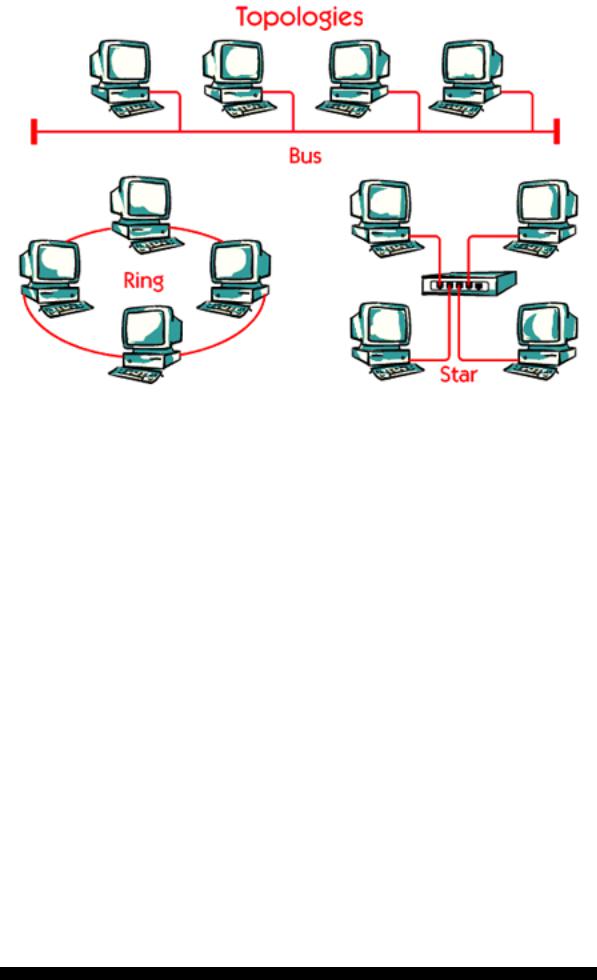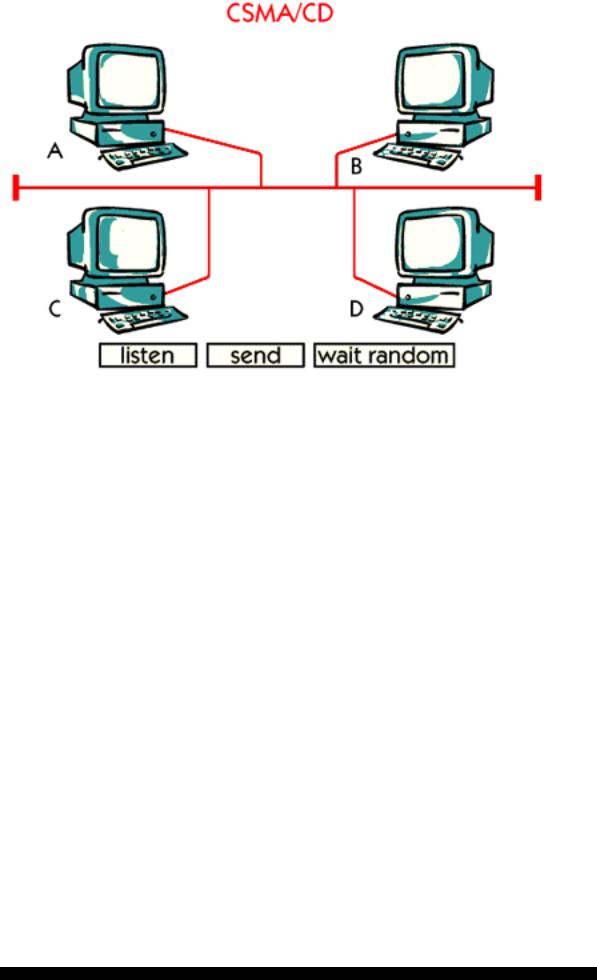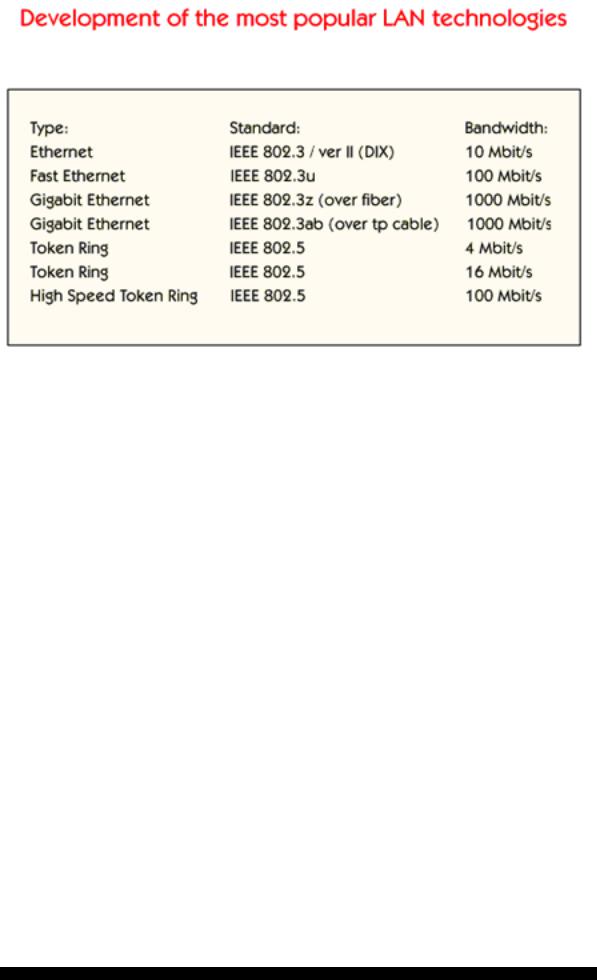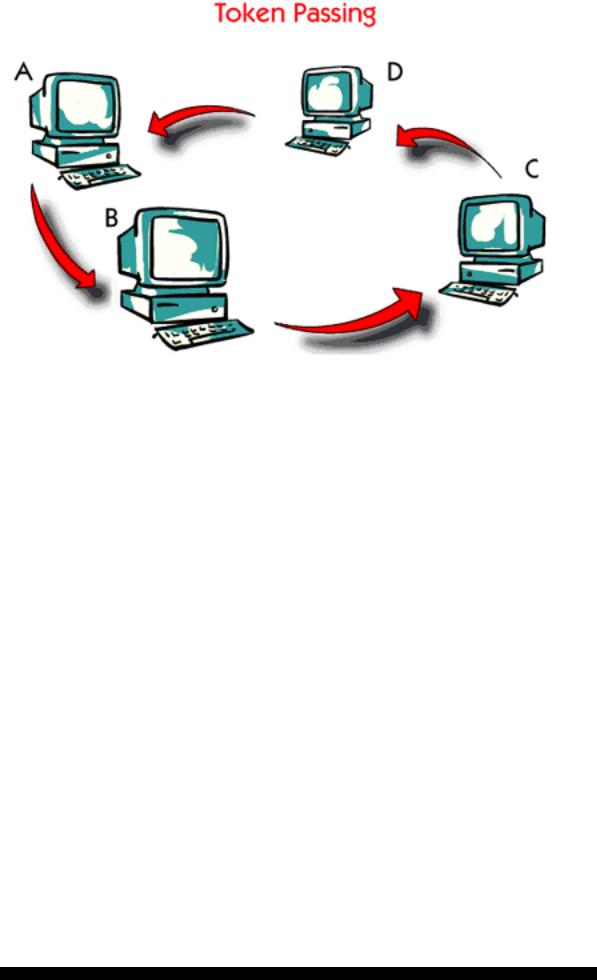
LAN
.pdf
Ch. 2 - LAN
1History
2Topologies
3Transmission medium
4Access Methods
5CSMA/CD
6Development of the most popular LAN technologies
7Token Passing
8Ethernet -Digital
9Ethernet - SUN
10Ethernet - in a mixed environment
11Token Ring
12Token Ring - IBM
13Token Ring - Novell
14Token Ring - in a mixed environment
15FDDI
16ATM
17LAN Components
18Switching methods
19VLAN - Virtual Local Area Network
20Port based VLAN
21MAC based VLAN
22Protocol based VLAN
23User based VLAN
1

Ch. 2 - LAN
In the mid 70's Robert Metcalf and David Boggs at Xerox experimented with communication between the computers. This became the first implementation of Ethernet.
In 1982, the second version of Ethernet was implemented by Digital, Intel and Xerox. This is the version of Ethernet that is still in use today.
In the mid 80's the first PC-networks started to appear. Network components such as bridges and routers were now available on the market.
The normal bandwidth of the Local Area Network today is 10 Mbps.
In the near future we will see higher bandwidths, such as 100 to 1000 Mbps.
2

Ch. 2 - LAN
The topology of a network concerns the physical configuration of the devices and the cables that connect them.
Three principle topologies are used for local area networks:
1. Bus network
On the bus network all connected hosts are sharing the same cable. All the hosts must use the same communication speed and every host ”hears” all traffic on the cable.
2. Ring network
In the ring topology all hosts are connected into a ring. Every host in the ring receives all data that is passing. If the data has another destination address, the host will re-transmit the data into the ring. The data will continue to travel in this way until it reaches the destination host.
3. Star network
A star configuration includes a central controller which could be a hub or a switch. Every host is directly connected to a port on the central controller.
3

Ch. 2 - LAN
IEEE standards for LANs describe different types of transmission media. It could be cable, fiber or wireless.
Cables:
Cables typically come in two flavors: twisted pair cables or coaxial cables.
Twisted pair cables
A twisted-wire consists of two insulated strands of copper wire that have been braided. Often a number of twisted-wire pairs are grouped together into a twisted pair cable. Twisted pair cables are used both for data communication and telephony.
In the picture the twisted pair cables would typically be used in the star topology in the middle, that is between the hub and the connected hosts.
Coaxial cables
Coaxial cables consist of a central conducting copper core that is surrounded by insulating material. The insulation is surrounded by a second conducting layer, which can consist of either a braided wire mesh or a solid sleeve. In the picture, the coaxial cable would typically be used for the bus network seen on the top.
Optical fiber:
Optical fibers can be used to carry data signals in the form of modulated light beams with high bandwidth. An optical fiber consists of an extremely thin cylinder of glass, called the core, surrounded by a concentric layer of glass. In the picture, the optical fiber would typically be used for the backbone network.
4

Ch. 2 - LAN
Wireless:
Different types of radio LANs are available on the market. This is an expensive type of LAN technique. In the picture, wireless connection is used between the two hosts with antennas. Wireless LAN connections are often used in old historical buildings where you are not allowed to install cables.
5

Ch. 2 - LAN
A characteristic common to all Local Area Networks is that multiple hosts have to share access to a single physical transmission medium. Several methods can be employed to control the sharing of access to the transmission medium.
The various access control methods can be characterized by where in the network the transmission control function is performed. An access method can use following forms of transmission control:
1. Random control
With random control any host can transmit and permission is not required. A host may check the medium to see if it is free before beginning to transmit.
2. Distributed control
With distributed control only one host at a time has the right to transmit and that right is passed from host to host. This is usually done by passing on a small piece of data called a token. The host that has the token, is the one that has the right to transmit.
6

Ch. 2 - LAN
CSMA/CD stands for "Carrier Sense Multiple Access with Collision Detect”. CSMA/CD is a random control access method.
The CSMA/CD access method is used as the access control method in Ethernet and is defined in a standard from IEEE. The CSMA/CD algorithm is quite simple and the efficiency for an ordinary Ethernet is about 65%. This means that the effective bandwidth for a 10 Mbps Ethernet is about 6.5 Mbps. The rest is lost, mainly due to collisions.
Before one host will transmit it must ”listen” on the medium whether or not another host is transmitting. If the medium is ”quiet” the host can send its data. The term "Carrier Sense" indicates that a host listens before it transmits.
"Multiple Access" means that many hosts can be connected to the network and all hosts have the same right to transmit.
With CSMA/CD, it occasionally happens that two hosts send their packets at the same time. This will make a collision on the network. The information about the collision is detected by all the other hosts on the network. This is called "Collision Detect". If a host detects a collision it will wait a random period of time before it tries to transmit again.
7

Ch. 2 - LAN
This diagram shows what has happened to the development of the two most used LAN technologies today, Ethernet and Token ring. 10 Megabits Ethernet exists in two versions. Version two as specified by Digital. Intel and Xerox, is the most commonly used version and IEEE standard 802.3 which is not so commonly used. These two versions are not compatible, because the frame format differs.
Fast Ethernet, which is specified in IEEE 802.3u, offers 100 Mbps. Fast Ethernet is a modern version of Ethernet and is often used in LAN backbone networks today (that is 1999), but is still not so commonly used for clients.
Gigabit Ethernet over fiber, is specified in IEEE 802.3z, offers 1000 Mbps. Gigabit Ethernet is not so common today (that is 1999). Gigabit Ethernet is only used in LAN backbone networks because it is expensive and there is not any need today for so high bandwidth to clients.
Gigabit Ethernet over twisted pair cable, is specified in IEEE 802.3ab, offers 1000 Mbps. This standard is not fully specified today, that is in the spring 1999.
Gigabit Ethernet is the future of LAN development, because Ethernet is simple, reliable and will become cheap.
Token ring as specified in IEEE 802.5 offers 4 and 16 Mbps. The use of token ring technology is diminishing even though a new standard, called high speed token ring, offering 100 Mbps, has been specified.
8

Ch. 2 - LAN
In Token Ring another access method is used, called Token Passing.
With Token Passing, a small message, called a token, constantly circulates around the ring. If the token is marked as free, the host that receives the ”free” token can transmit its data and mark the token as busy. All the hosts along the ring receive the data and the busy token, until the host that sent the original message sets the token free again.
Right now the token is with host B, and it is marked free. Let’s say that host B wants to send data to host D. B sets the token to busy and adds its data.
The host C has now received the token and the data, but since C is not the receiver it just passes on the token and the data into the ring.
The host D receives the data and sets the token to copied. The token and the data are then passed on into the ring.
The host A just passes on the token and the data.
The host B sees that the data has been received in a proper way by D. B therefore deletes the data and sets the token free again.
9

Ch. 2 - LAN
Ethernet, as defined in IEEE 802.3 standard, can use both star and bus topology with bandwidths between 10 and 100 Mbps. Ethernet is today the most common technique used in Local Area Networks.
Digital uses Ethernet for communication between their products. This picture represents an early implementation by Digital. You can see that Vax computers can be accessed by VT220 terminals, through a terminal server.
10
